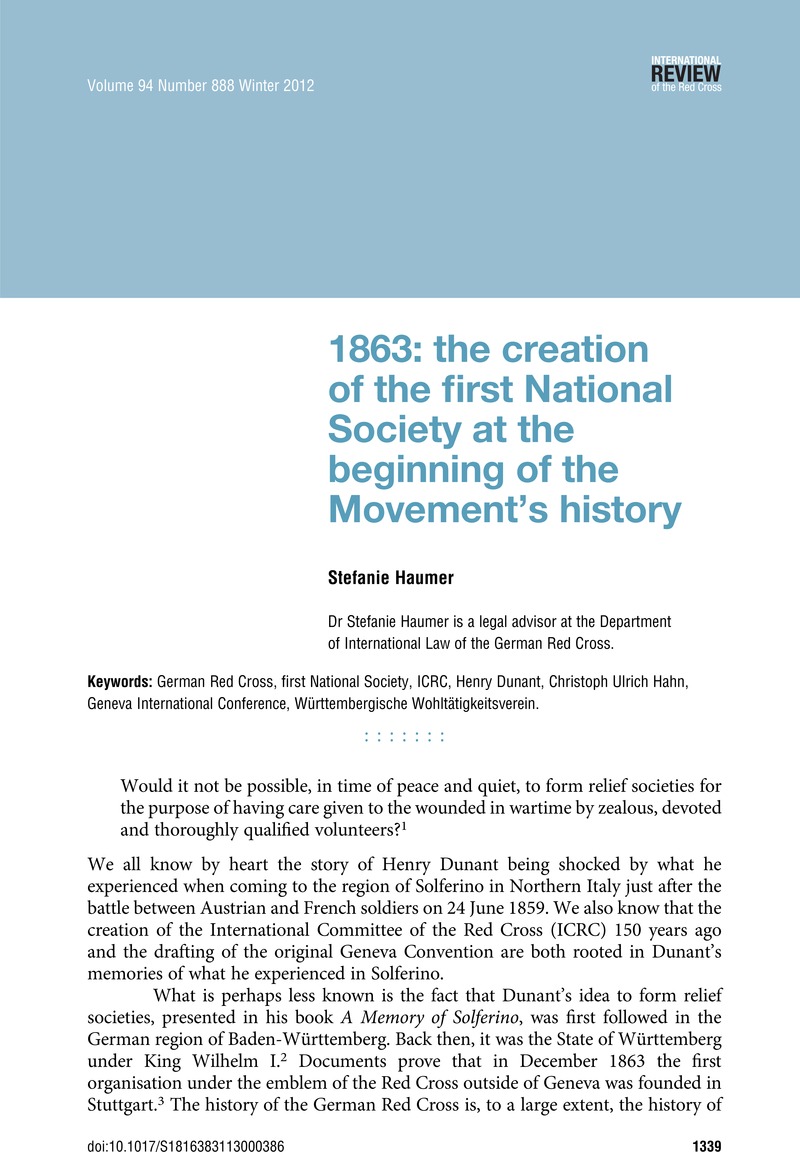No CrossRef data available.
Article contents
1863: the creation of the first National Society at the beginning of the Movement's history
Published online by Cambridge University Press: 24 October 2013
Abstract

Keywords
- Type
- Turning points in the history of the ICRC and the Movement
- Information
- International Review of the Red Cross , Volume 94 , Issue 888: ICRC: 150 years of Humanitarian Action , December 2012 , pp. 1339 - 1347
- Copyright
- Copyright © International Committee of the Red Cross 2013
References
1 Dunant, Henry, A Memory of Solferino, English version, ICRC, Geneva, 1939, p. 115Google Scholar.
2 King Wilhelm I died in 1864 and was succeeded by King Karl I.
3 For further details, see below. ‘Liste des Comités Centraux, d'après l'ordre chronologique de leur fondation’, in Bulletin international de la Croix-Rouge, No. 15, April 1973, p. 137; Walter Gruber, 125 Jahre Rotes Kreuz, Schwaikheim, 1988. Crucial inventories relating to the time from the creation of the first organisation until the end of World War II of the specific archive in Potsdam-Babelsberg went missing or were scattered due to disturbances at the archive at the end of World War II. Alfred Quellmalz even dates the creation of the first organisation back to 12 November 1863; see Quellmalz, Alfred, Dr Christoph Ulrich Hahn, Lebensbilder aus Schwaben und Franken, Stuttgart, 1962, p. 197Google Scholar; see also Weller, Arnold, Sozialgeschichte Südwestdeutschlands, Stuttgart, 1979, p. 182Google Scholar; Gruber, Walter, ‘Baden-Württemberg: eine Wiege des Roten Kreuzes in Deutschland’, in Hundert Jahre im Dienst der Menschlichkeit, Deutsches Rotes Kreuz Schriftenreihe, Bonn, No. 30, 1963, p. 99Google Scholar.
4 For more detailed information see ‘Baden-Württemberg’, in W. Gruber, above note 3.
5 This association had emanated from the Central Foundation for Poverty Relief, which Queen Katharina of Württemberg created in 1817. As chair of the Württembergische Sanitätsverein, Hahn was in contact with Gustave Moynier, president of the Geneva Society for Public Welfare (la Société genevoise d'utilité publique) at that time. See ibid., p. 102.
6 Ibid.
7 In 1876, Dr Wagner would offer Dunant a home when the latter was poor and very much in need.
8 See Gruber, Walter, Das Rote Kreuz in Deutschland, Wiesbaden, 1985, pp. 14 ffGoogle Scholar.
9 Baden, Bavaria, France, Great Britain, Hanover, Hesse-Darmstadt, Italy, The Netherlands, Austria, Prussia, Russia, Saxony, Sweden, and Spain. There were also six delegates of various associations, seven unofficial foreign participants, and the five members of the ICRC.
10 For the Member States of the German Confederation see the list at German Historical Museum, available at: www.dhm.de/lemo/html/reaktion/deutscherbund.
11 W. Gruber, ‘Baden-Württemberg’, above note 3, pp. 108 ff.
12 Ibid., p. 110.
13 Ibid.
14 The Badischer Frauenverein was created 6 June 1859 in Karlsruhe by Grand Duchess Luise von Baden, and formally acknowledged by the ICRC on 29 June 1866. From the start, however, it worked in the same sense as it did after the formal acknowledgment by the ICRC, in the sense of being a Red Cross Society. Furthermore, the Grand Duchy of Baden was the first German state to ratify the Geneva Convention on 16 December 1864, while the Kingdom of Württemberg followed on 2 June 1866. Baden was the ninth state on the whole to ratify the Convention.
15 W. Gruber, ‘Baden-Württemberg’, above note 3, p. 111.
17 ‘The work itself would consist in bringing aid and relief (in agreement with the military commissaries, i.e., when necessary with their support and under their instructions) onto the battlefield whenever battle was joined, and subsequently to continue to care for the wounded in the hospitals until their convalescence was complete’: H. Dunant, above note 1, p. 117.
18 To what extent this attracted public interest is not known.
19 W. Gruber, ‘Baden-Württemberg’, above note 3, pp. 112 ff.
21 Ibid.
22 Ibid.
23 Ibid.
24 For further societies formed between 1863 and 1877, see W. Gruber, 125 Jahre Rotes Kreuz, above note 3, p. 13.
25 A. Quellmalz, above note 3, p. 203.
26 Ibid.
27 This concept of auxiliarity – which is still of paramount importance today – is the specific and distinctive partnership between the National Red Cross and Red Crescent Societies and their respective states. It balances the responsibilities of a National Society within a state against the principle of independence according to which every component of the Red Cross and Red Crescent Movement works. The concept entails mutual responsibilities and benefits and is based on international and national laws, in which the state and the National Society agree on the areas in which the latter substitutes for public humanitarian services. See ICRC, ‘31st International Conference 2011: Resolution 4 – Furthering the auxiliary role’, Resolution, 1 December 2011, available at: www.icrc.org/eng/resources/documents/resolution/31-international-conference-resolution-4-2011.htm. It is worth noting that, as the German Confederation could not agree on one delegate to represent all the states at the International Conference in Geneva in 1864, Dr Hahn was authorised to participate in the Conference for the State of Württemberg. In his letter of 22 July 1864 to the ICRC in which he announced this fact, he also proposed the idea that it might be helpful if delegates of all newly created societies would confederate.
28 A. Quellmalz, above note 3, p. 200.
29 See above note 14. Hesse joined on 22 June 1866, Bavaria on 30 June 1866. Saxony was only able to join after the war on 25 October 1866, as it was already under occupation by Prussia in June. Under the influence of King Karl I, Austria joined on 21 July 1866.
30 See also the German–Danish war, February–October 1864.
31 Crown Princess Olga was married to King Karl I and thus became Queen in 1864.
32 A. Quellmalz, above note 3, p. 200.
33 Ibid., p. 201.


